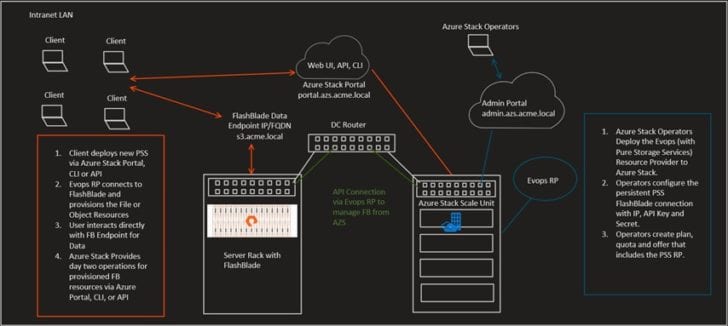In recent years, the major cloud service providers—Amazon, Google, and Microsoft—have made substantial investments as more organizations make the move to hybrid cloud. Many organizations have moved to hybrid-cloud environments. And others are in the process of making the move.
Along the way, many have discovered that several factors come into play when deciding whether or not to run workloads in a hybrid-cloud architecture, including:
- Costs
- Data sovereignty
- Performance
- Network connectivity
Microsoft Azure Stack is the only solution that can run in both a hybrid or fully disconnected deployment. This makes Azure Stack Hub an attractive option for companies and government agencies that have a cloud strategy but run environments that aren’t connected to the internet.

Source: Microsoft
Azure Stack Hub offers a limited subset of features and services that you will find in the Azure cloud hosted by Microsoft. From an infrastructure-as-a-service perspective, Azure Stack Hub provides the full capabilities to run Azure VMs, Azure Networks, Azure Load Balancers, and Azure Storage accounts. Azure Stack Hub also offers several platform-as-a-service (PaaS) offerings: Azure Kubernetes Service, Azure Key Vault, Azure SQL and MySQL, Azure Web Apps, and Azure Functions. Several more are in preview.

Source: Microsoft
Pure Storage® FlashBlade® Integration with Azure Stack
Azure Stack Hub offers storage for block and page blob, table, and queue only through Azure Stack Storage accounts. Pure saw an opportunity to integrate the FlashBlade unified fast file and object (UFFO) platform with Azure Stack Hub to provide NFS, SMB, and S3 object storage. You can deploy and manage FlashBlade file systems and S3 object accounts directly from the Azure Stack Hub portal as well as through the Azure Resource Manager.
A Closer Look at the Integration
Microsoft uses the concept of a resource provider to handle the logic for provisioning a resource on the user’s behalf. The core resource providers in Azure Stack Hub are Compute, Network, and Storage. They provide the instructions to deploy VMs, networks, NICs, load balancers, and storage accounts. Microsoft also has a few optional resource providers (or add-on providers) for App Services, SQL, and MySQL. They enable the PaaS capabilities of Azure Web Apps, Azure Functions, SQL as a service, and MySQL as a service.
In addition, Microsoft has allowed two companies to deploy a third-party resource provider into an Azure Stack Hub. Gridpro Software is one of those companies. Pure partnered with Gridpro to add integration into its existing EvOps resource provider for Azure Stack Hub. As a result, you can integrate one or many FlashBlade namespaces directly into the Azure Stack Hub portal via a third-party resource-provider deployment model. This integration enables native provisioning and management of FlashBlade file systems and object accounts directly from the Azure Stack Hub portal, CLI, and ARM interface. It extends all the benefits of the FlashBlade high-performance file and object data hub directly to Azure Stack Hub.


Source: Microsoft
Logical Architecture

Source: Microsoft
The installation of the Gridpro resource provider is straightforward. Once enabled, you have the option to deploy Pure File and Object accounts from within the Azure Stack Hub portal (Figure 3).

Updated Information
1. Advancements in FlashBlade Technology:
- Introduction of FlashBlade//S: In June 2022, Pure Storage announced the FlashBlade//S series, featuring a modular architecture that disaggregates compute and capacity, allowing for independent scaling of resources. This design enhances flexibility and performance for modern unstructured data workloads.
- Unified Fast File and Object (UFFO) Storage: FlashBlade//S consolidates native fast file and object storage, delivering simplicity, scalability, and high performance for diverse workloads.
2. Enhancements in Azure Stack Hub:
- Expanded Storage Services: Azure Stack Hub has broadened its storage services to include Blob storage for unstructured data, Table storage for structured datasets, and Queue storage for message queuing. These services enhance the platform’s versatility in handling various data types.
- Improved Data Transfer Tools: The platform now supports tools like Blobfuse, a virtual file system driver for Azure Blob Storage, enabling seamless access to blob data through the Linux file system. This integration simplifies data management across different environments.
3. Integration Benefits:
- Enhanced Data Governance: The integration of FlashBlade//S with Azure Stack Hub allows organizations to manage large-scale file and object repositories while adhering to strict data governance requirements, such as data sovereignty and compliance mandates.
- Consistent Tooling: Organizations adopting Azure cloud services tools and workflows benefit from consistent tools and processes across both cloud and on-premises environments, facilitating a unified management experience.
Conclusion
The advancements in FlashBlade technology and Microsoft Azure Stack Hub’s storage capabilities have significantly enhanced the integration’s performance, scalability, and versatility. Organizations can now leverage these improvements to effectively manage their hybrid-cloud architectures, ensuring high performance and compliance with data governance requirements.
The integration of Pure FlashBlade into Azure Stack Hub delivers a fast file and S3 object storage solution for your cloud strategy. ![]()

BUYER’S GUIDE, 14 PAGES
Reevaluating Your Virtualization Strategy?
Explore your options in our guide to modern virtualization.
Simplicity and Agility
Put the industry’s most advanced all-flash storage solution to work for your organization.






